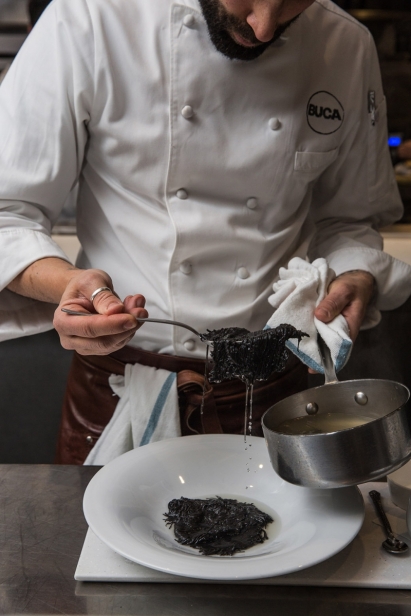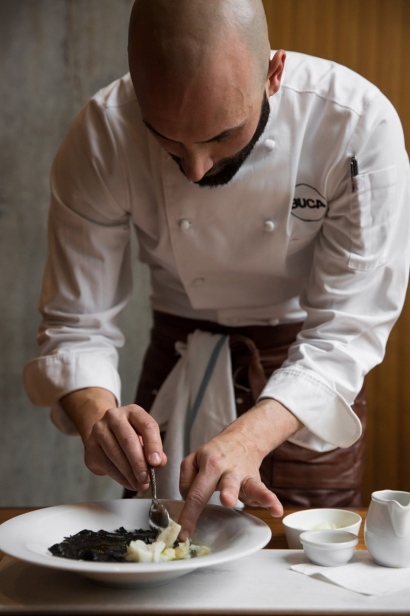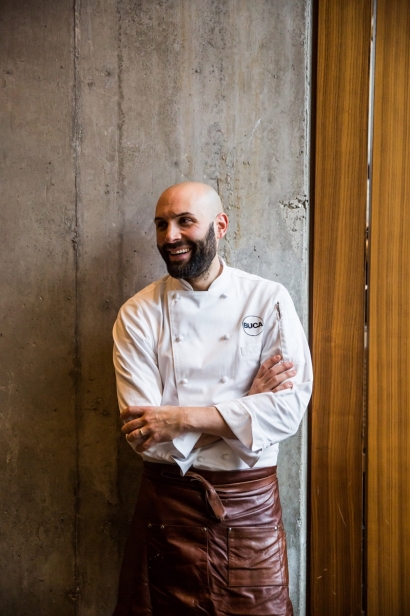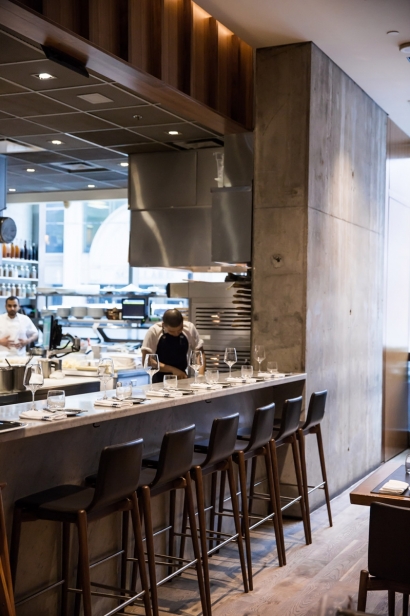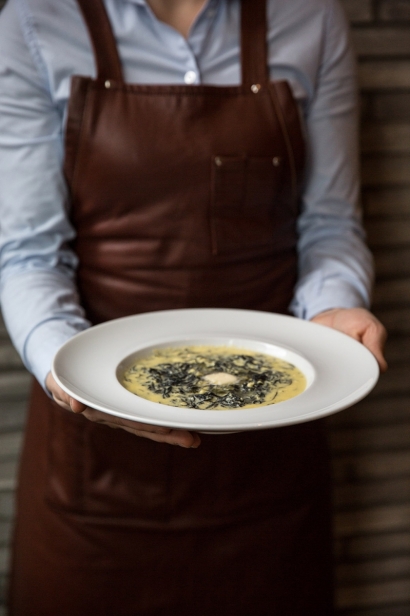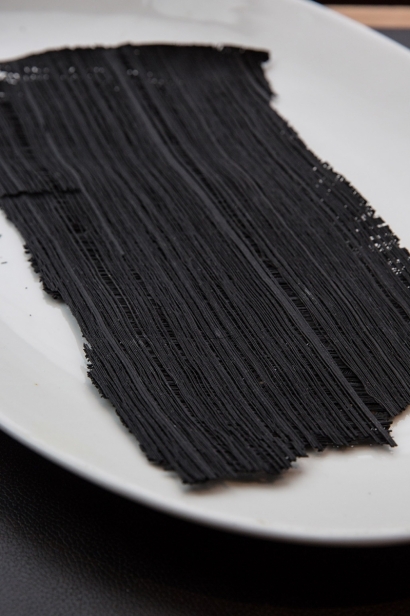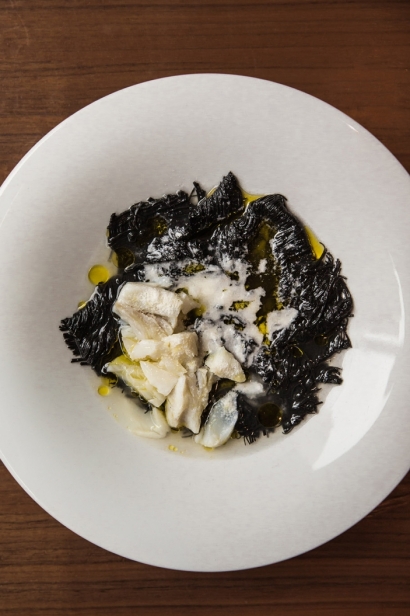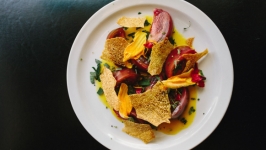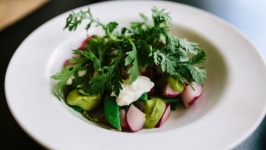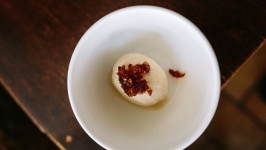Threads of God
Su filindeu, the world’s rarest and priciest pasta (at $150 per kilogram) looks rather humble sitting on a plate, like a rectangle of simple cheesecloth starched into an unyielding board.
Holding it up to the light reveals complex artistry in the overlapping cross hatches of ultra-fine dried pasta that underscore the English translation of its Italian name: “the threads of God.”
What makes this sheet of su filindeu even more dramatic is the colour: it’s stained deep, matte back with squid ink.
Rob Gentile, executive chef of Buca Restaurants and chef director of King Street Food Company, calls su filindeu a “unicorn ingredient.”
“I was beside myself,” Gentile says of when he learned he could get what seemed to be the unobtainable, this pasta hand-made by only a few women in the town of Nuoro, Sardinia.
Montreal-based Italian food importers and self-described “ingredient hunters” Barbara Adly and her husband, Pietro Canali, of Cucina Fine Foods approached Gentile in 2017 to see if he was interested in the hard-to-find artisanal and heritage items from small producers they were importing from Canali’s native Italy.
Could they get su filindeu, Gentile asked them? They could, making the two Toronto Buca restaurants the only places in North America serving it.
Gentile ordered the pale straw-coloured natural version first for Buca on King St. W. It’s served in lamb broth that echoes the traditional way its eaten in Nuoro, where it’s cooked in mutton soup. It comes with a sous vide-cooked lamb neck, the tender meat presented on the side to be shredded and added to the soup, along with a dusting of Pecorino cheese.
Inspired by a photo he had seen in an Italian book of a black version of the pasta, Gentile asked Adly and Canali if the women could make the next order with squid ink for seafood-forward Buca Osteria & Bar in Yorkville.
The squid ink su filindeu arrived just before Christmas. It’s the colour of charcoal, turning shiny ebony as it cooks, yet it imparts no colour and little flavour beyond what Gentile calls the “aura” of the sea in the two dishes he created for the menu at Buca Yorkville.
Both are based on a truly Canadian ingredient, a profoundly rich broth made from smoked Newfoundland capelin. Gentile likens it to smoked bonito in its flavour profile.
For the dinner item, a sheet of su filindeu is broken into chunks roughly the size of a deck of playing cards and cooked briefly in the broth to ensure it holds its shape. The soup gets a swirl of unfiltered olive oil, while a lightly poached chunk of meaty Fogo Island cod is served on the side, along with some finely grated Pecorino cheese, allowing diners to assemble it as they wish.
“You’ve got to cook it right, perfectly,” Gentile says of the pasta. “We serve it with a little bit of firmness to it. Sitting in the broth, it starts to melt.”
The pasta feels like a woven raft on the tongue, delicate and silky in the sublimely salty-umami broth.
The brunch version may be the best hangover dish in the city: Gentile’s luxurious take on traditional Stracciatella soup. The smoked capelin broth is the base, thickened with a marigold coloured egg beaten with Pecorino and slowly poured into the hot liquid. The cooked su filindeu threads are pulled apart to fill the thick yellow soup with fine black squiggles.
It’s believed that only three women in the world have mastered the 300-year-old technique for making the rare pasta. The version served at Buca is crafted by Raffaella Marongiu.
Gentile explains the process of making su filindeu. It’s just three ingredients: fine semolina, salt and water, kneaded well, rolled out in a long sausage shape and repeatedly folded and pulled until it makes 256 angel hair-like strands. These are stretched and layered across each other, pulled over a round woven form to dry in the sun, then broken into chunks for cooking.
The process has become a YouTube darling. You can watch Paola Abraini make gossamer strands of su filindeu and see celebrity chef Jamie Oliver fail miserably at it during a lesson with Abraini, who has been making the pasta for more than 40 years.
Gentile hasn’t had success making su filindeu either. The process is a bit like the method for making Chinese la mian noodles, but the results are thinner. The magic is in knowing exactly when the gluten in the finely milled semolina-based dough is ready.
“It’s the texture of the dough and at that moment when they are able to pull the semolina, the gluten needs to be [at the] right amount of elasticity in order for it to pull and not break,” Gentile says.
“They know by the feel of it when they can pull and the strands will go thin, like hair.”
Adly says keeping foods such as su filindeu from being forgotten is “the core of everything that we do and why we started the business and why we love what we do.”
Gentile is like-minded, taking food stewardship seriously.
“I think the very first responsibility of any chef is their understanding of sustainability and their understanding not just of sustainability, but being able to go out of their way to create an environment where you are able to purchase ingredients from people who are putting authentic passion into it,” he says.
Because so few can make su filindeu, it’s in danger of becoming a lost food.
Raffaella Ponzio of Slow Food International’s Ark of Taste preservation project said in a 2016 BBC Travel story that “conserving su filindeu isn’t just a question of a culinary art form, but also a piece of cultural identity.”
Gentile says it’s a bucket list item for him to go to Nuoro and learn how to make su filindeu. “I need to spend a week there in order to do it right. I can’t just go and watch. I need to get into it.”
He could pass the technique on to others. “I think authenticity is all about sharing and not keeping things secret,” he says. “By sharing you are keeping that authenticity alive.”
Squid ink, whether fresh or jarred, is part of that authenticity, too, and a core Italian ingredient, Gentile says. He puts it alongside bottarga (salted, cured fish roe) and pasta al pomodoro as a bedrock element of Italian cuisine.
“Ink is a very special ingredient," Gentile says. Ink screams Italian. If you love Italian food, you really should know how to make a nice squid ink dish.”
He’s worked with ink many different ways, he explains, even in a dessert.
“It’s amazing and I’m probably going to put it back on the menu,” he says of the dense, chocolaty-sweet torta caprese made with squid ink. After all, “salt and chocolate love each other,” Gentile says. At Buca on King St. W., he does a take on the classic black spaghetti al nero di seppia, but substitutes pork blood for the squid ink to make spaghetti al nero di maiale.
Gentile makes these dishes for flavour, not because of the current Instagram-fed fixation with black foods.
“I don’t like food that’s meant to be cool just because it looks cool,” he says. “If it’s a fad, I really don’t care. If it tastes damn good, who cares what it looks like?”
Buca Osteria & Bar
53 Scollard St. and 604 King St. W., Toronto, Ont.
buca.ca, 416.962.2822



